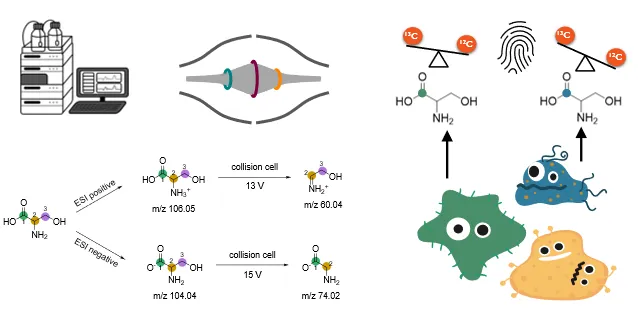Position-specific isotope analysis of serine via Orbitrap mass spectrometry

Position specific 13C/12C analysis at natural abundance in the amino acid serine is targeted by Orbitrap mass spectrometry. The goal is to monitor the metabolism and origin of legionella for which serine serves as nutrient.
Serine is a proteinogenic amino acid and an essential nutrient for the bacterium Legionella pneumophila, which relies on serine as its primary source of carbon and energy. Consequently, variations in the metabolism of L. pneumophila are expected to be reflected in the carbon isotope ratios of serine within its proteins.
Traditional methods for serine isotope ratio analysis have relied on bulk isotope analysis of pure serine using EA-IRMS, with position-specific analysis of the carboxy carbon achieved through ninhydrin reaction and subsequent CO2 measurement. Comprehensive position-specific isotope analysis of serine has previously required extensive derivatization for GC-Orbitrap analysis.
We explored a novel method for position-specific isotope analysis of serine using ESI-Orbitrap, eliminating the need for derivatization. This method combines whole-molecule isotope ratio measurements with those obtained from various fragments generated in a collision cell, in both positive and negative ESI modes.
To support this method, we have prepared homogeneous position-specific carbon isotope standards for all carbon atoms in serine, resulting in eight distinct standards with varying 13C/12C isotope ratios. These standards enable precise calibration and referencing of serine isotope measurements on the Orbitrap mass spectrometer and facilitate inter-laboratory comparisons of measured isotope ratios.
In the future it is our objective to conduct metabolic studies of L. pneumophila by monitoring the change of serin carbon isotope ratios without the need of expensive 13C-labeled serin in the growth medium. This might also allow metabolic studies of L. pneumophila samples directly in environmental settings.